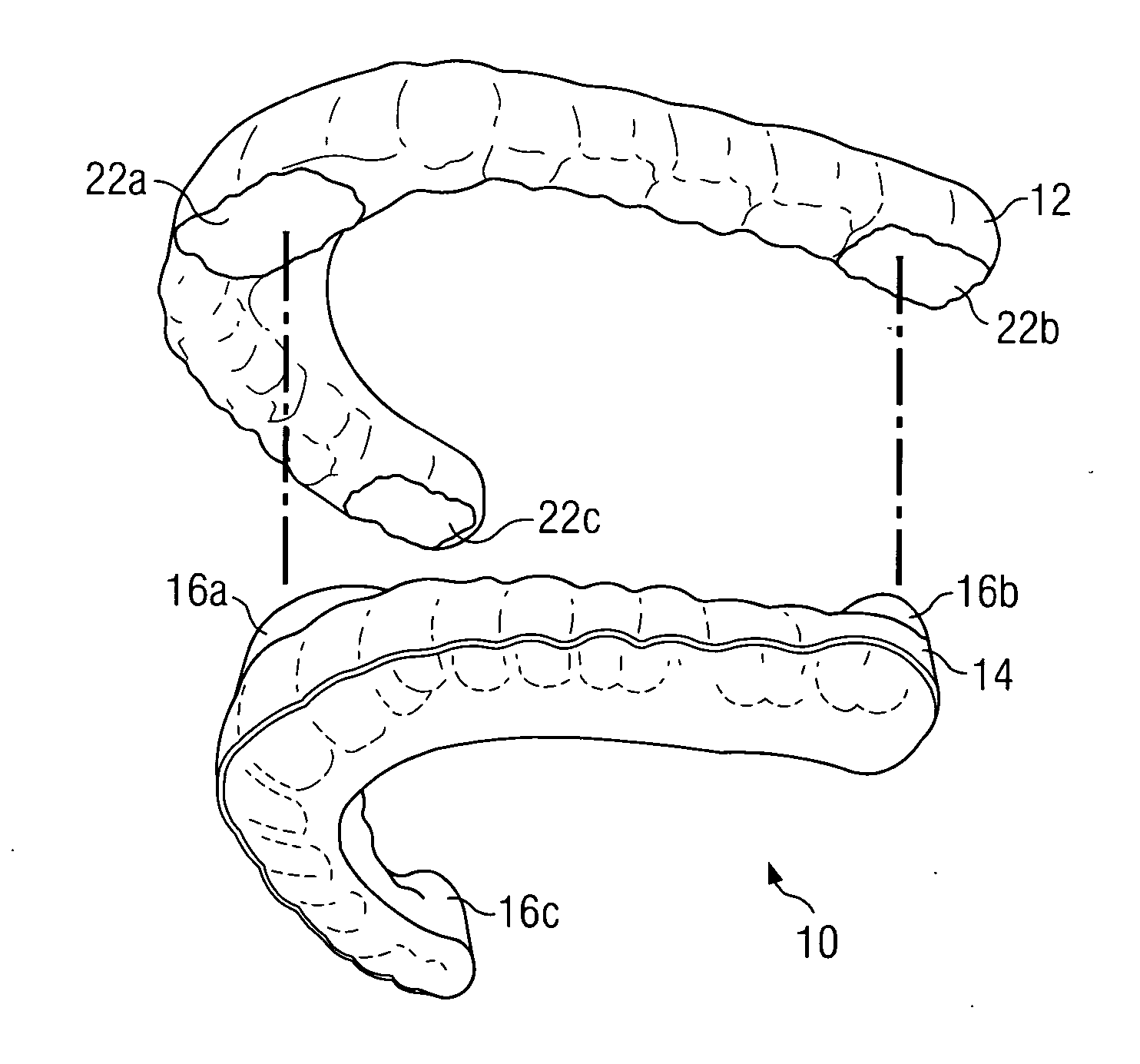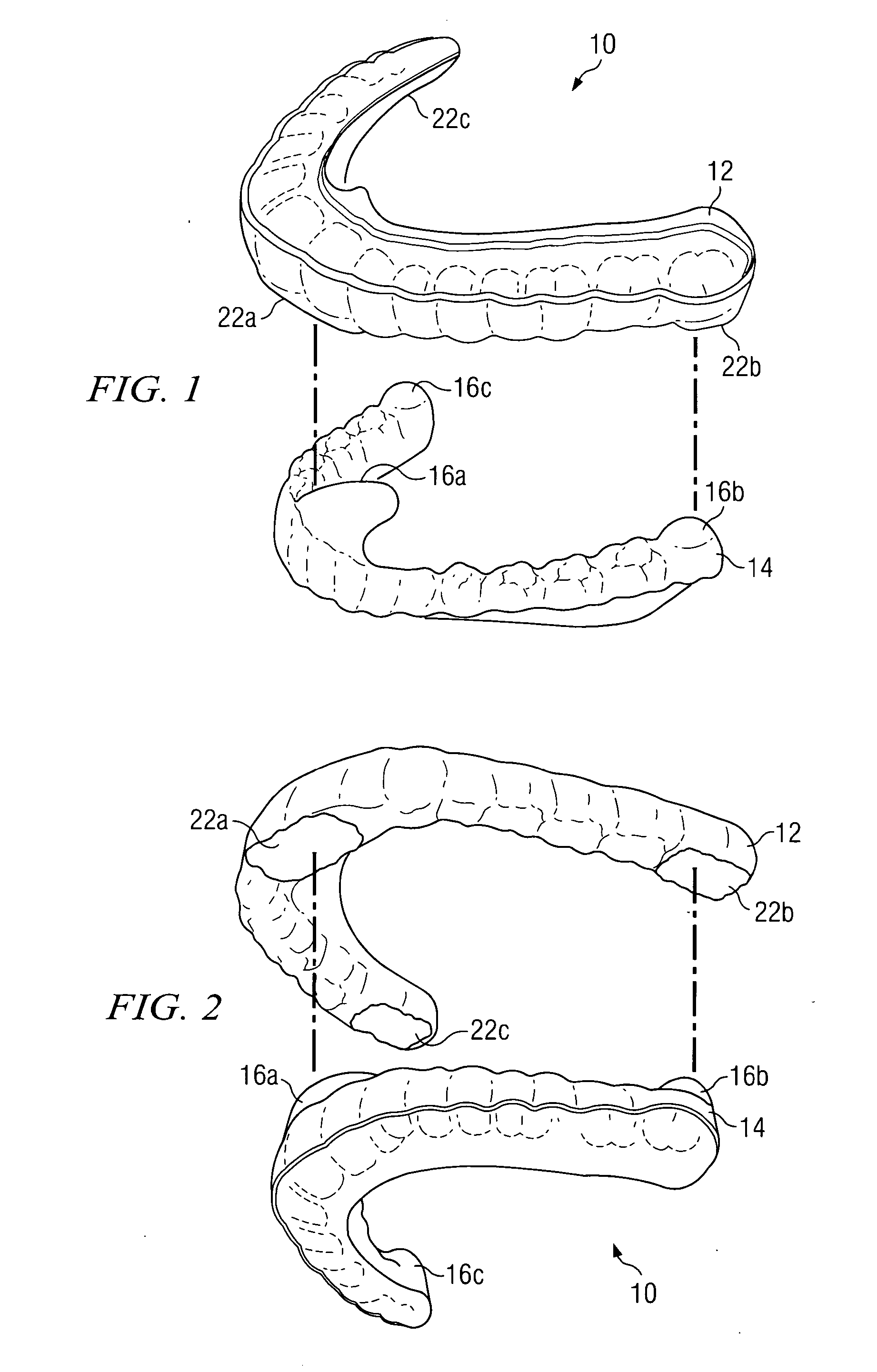[0007] The oral appliance of the present invention may reduce or eliminate problems and disadvantages associated with previous oral appliances.
[0008] According to one embodiment, an oral appliance for maintaining stability of one or more aspects of a user's masticatory system includes a first arch adapted to receive at least some of the user's teeth and a second arch adapted to receive at least some of the user's teeth. The first arch includes an anterior substantially planar region
proximate a midline of the first arch. The second arch includes an anterior bearing platform located proximate a midline of the second arch, elongated in an anterior-posterior direction, and operable to contact the anterior substantially planar region of the first arch when the user bites down with the oral appliance inserted in the user's mouth and the user's temporomandibular joint in its proper
natural position to help maintain stability of one or more aspects of the user's masticatory system.
[0010] According to another embodiment, a method is provided for monitoring stability of one or more aspects of a user's masticatory system. An oral appliance is provided that includes a first arch and a second arch each adapted to receive at least some of the user's teeth. The first arch is operable to contact the second arch at only an anterior bearing platform of the second arch when the user bites down with the oral appliance inserted in the user's mouth and the user's temporomandibular joint in its proper
natural position to help maintain stability of one or more aspects of the user's masticatory system. The anterior bearing platform is located proximate a midline of the second arch and elongated in an anterior-posterior direction. The oral appliance is inserted into the user's mouth and an impression material is introduced between the first and second arches. A first impression
record is created using the impression material, indicating that the first arch is operable to contact the second arch at only the anterior bearing platform when the user bites down with the oral appliance inserted in the user's mouth and the user's temporomandibular joint in its proper natural position. At a subsequent time, the oral appliance is again inserted into the user's mouth and an impression material is again introduced between the first and second arches. A second impression
record is created using the impression material, indicating whether the first arch is operable to contact the second arch at only the anterior bearing platform when the user bites down with the oral appliance inserted in the user's mouth and the user's temporomandibular joint in its proper natural position. The second impression
record is compared to the first impression record. If the second impression record matches the first impression record, it may be determined that one or more aspects of the user's masticatory system have remained stable over a period of time between creation of the first and second impression records.
[0011] Particular embodiments of the present invention may provide one or more technical advantages. For example, in particular embodiments, an oral appliance is provided with upper and lower arches that may be constructed and “balanced” such that a first arch contacts a second arch only at one or more bearing structures, and such that the first arch contacts all one or more bearing structures at substantially the same time (where multiple bearing structures are provided) when the user bites down and the user's temporomandibular joint is in its proper natural position. When the oral appliance is in use, the one or more bearing structures may be permitted to move substantially freely within corresponding substantially planar regions. However, in particular embodiments, due to the natural movement of the user's lower jaw about the joint, only a single anterior bearing structure remains in contact with its corresponding anterior substantially planar region when the user is not
biting down and the lower jaw is retracted. In particular embodiments, the single anterior bearing structure is formed such that it remains in contact with its corresponding anterior substantially planar region regardless of positioning or movement of the lower jaw. In particular embodiments, the anterior bearing structure is an anterior bearing platform, elongated in the anterior-posterior direction, provided on the lower arch. This may allow the lower jaw to be extended or otherwise moved in an anterior direction to a significant extent while maintaining at least a posterior portion of the anterior bearing platform in contact with the corresponding anterior substantially planar region. Because the oral appliance ensures that the joint is in its proper natural position when the user bites down, particular embodiments may not only reduce or eliminate the symptoms of grinding of the teeth (e.g., excessive wear of the teeth), but may further address and remediate the underlying physiological cause—improper positioning of the joint and associated musculature.
[0012] In particular embodiments, the present invention may eliminate the difficult and time-consuming task of constructing an oral appliance such that: (1) where two arches are provided, a significant portion of the surface of the upper (or lower) arch substantially simultaneously contacts a significant portion of the opposing surface of the lower (or upper) arch, or (2) where a single arch is provided, the surface of the upper (or lower) arch substantially simultaneously contacts all or most of the user's opposing lower (or upper) teeth. The use of posterior bearing structures in addition to an anterior structure may reduce the amount of force transferred to the joint when the user bites down to approximately five percent of the force applied, which may be approximately the same as if the entire surfaces of first and second arches contacted each other at the same time. Thus, in particular embodiments, the present invention may provide the same or similar advantages as such an arrangement, while reducing the complexity and time involved in construction. In addition, the use of one or more bearing structures and corresponding substantially planar regions may allow the first and second arches to be thinner and more comfortable to wear.
[0013] In particular embodiments, a dentist or other clinical professional may monitor the stability of the user's temporomandibular joint, associated musculature, teeth, or one or more other aspects of the user's masticatory system over time according to a series of impression records created using the oral appliance. For example, if the monitoring indicates that the joint has remained sufficiently stable over a period of time between the creation of successive impression records, then the dentist or other clinical professional may be comfortable finalizing the user's case. If not, then the dentist or clinical professional may wish to modify the oral appliance, such as by modifying one or more bearing structures, to attempt to achieve such stability. In particular embodiments, monitoring may be conducted in connection with the initial fitting and construction of the oral appliance, such as over a period of less than one hour. In particular embodiments, monitoring may be conducted over a longer period, such as over a period of between one week and one year. In particular embodiments, such monitoring may allow a dentist or other clinical professional to make more
effective treatment decisions and more accurately predict the likely effects of those decisions.
 Login to View More
Login to View More  Login to View More
Login to View More 


